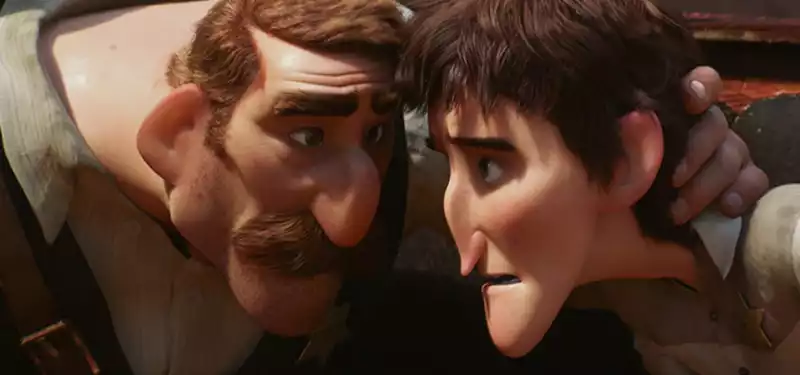Jul 29, 2016
How Andrew Coates and Lou Hamou-Razi made their independent short film "Borrowed Time" within Pixar
Producing an animated short film independently is difficult. But what if you had the power of Pixar's animation toolset and render farm? This short won Oscar-caliber awards at the St. Louis and Nashville film festivals and again this week at the Seagraf Computer Animation Festival, where it won the top prize.
Cartoon Brew interviewed the filmmakers at SIGGRAPH about how they made independent shorts within Pixar and how doing so helped and sometimes hindered their production.
"Borrowed Time" was made possible through Pixar's Co-op program, part of Pixar University, Pixar's in-house professional development program. Employees can apply and, if accepted, are allowed to use the Pixar pipeline at work on their own time. Interestingly, "Borrowed Time" was the first CG film to be accepted; most previous co-op films have been live-action.
This presented one of the first challenges for the filmmakers.
This was one of the first challenges for the filmmakers, as other filmmakers had traditionally only used the live-action equipment available in their studios and had not necessarily adopted a complete animation workflow. There were a lot of technical hurdles," said Coates, a Pixar animator. Coates, an animator at Pixar, said, "There were a lot of technical hurdles. So we had to build everything up.
Building a pipeline for a short film was also a challenge in Pixar's ever-changing technology environment. In other words, the workflow that the directors could do based on what Pixar had done for Monsters University would change when they switched to Inside Out. The pipeline for "Borrowed Time" was changed three times in five years to bring it up to par with Pixar's work.
The most difficult part of these pipeline issues was that Coates and character artist Hamow-Raj were on the front end of most Pixar films. Therefore, they had to either learn or convince other Pixar artists to help them (only Pixar-affiliated employees could be involved in the film production that occurred at the studio). The other artists participated in the production of the short films after work hours, during lunch breaks, and on weekends.
Having access to technology and a render farm was of course a great benefit, but it did not free up the directors. They had to make sure that the work didn't "overlap with the work in progress at Pixar. Still, who could afford that?
Coates and Hamow-Rudge embarked on a story development process that lasted several years before they actually joined Pixar. The idea of making a short film began when they were still in school together. After graduating from NYU's Tisch School of the Arts, the two worked separately at Pixar (Hamow-Rudge) and Blue Sky Studios (Coates). However, after Coates moved to Pixar in 2010, the production of Borrowed Time began in earnest.
One idea the two had been warming to for some time was a Western-type story. At that stage, they planned to develop what Coates calls "a goblin-like short, action-based, fun and frenetic." Eventually they realized that they were not satisfied with the story they were telling, and Hamou-Razi pointed out that "if it takes this long to do something, it better have a little more substance."
Aiming for a short film of less than 10 minutes (the final cut was less than 7 minutes), the directors reworked the sheriff's story several times. For example, many characters were added for the purpose of setting up a moment of betrayal around the main character, the sheriff, before settling on the main theme of forgiveness. Also, a three- to four-minute long heist scene was added, but cut after recognizing that it was mostly action and did not serve the storyline.
Both directors told Cartoon Brew that executing the story cuts was one of the major learning curves in the production. For example, one of the main characters, an old man, was conceptualized, modeled, rigged, groomed, textured, and then removed from the film. In other words, "We spent so much time on him that it influenced our decision to cut him. The decision to remove him was heartbreaking."
Another takeaway for the directors was the amount of time they would spend on the film. Some weeks they worked until the wee hours of the morning, and they still did not have a clear idea of all the steps required. That was until they brought in Amanda Deering Jones, who had been a script supervisor at Pixar, as a producer. Hamow-Raj joked, "She's very good at what she does, and we're very bad at what we do." She contacted composer Gustavo Santaolalla ("Brokeback Mountain," "Babel," "The Last of Us") and had connections with Skywalker Sound for the final sound design. And according to the directors, Jones was very familiar with the concept of "temporary love" in the temporary laydowns established in Animatics. Hamou-Lhadj, for example, admits to being too devoted to the temporary tracks in The Last of Us before hearing Santolalla's original music for the short.
Coates and Hamou-Lhadj are currently chaperoning the film at various film festivals and spoke about their work at SIGGRAPH earlier this week. Asked if this story, or another, could set the stage for a feature-length version, the directors said it was too early to tell. Said Coates, "We'd love to do a feature-length version." We've spent five years in this world and now we're itching to do something new."
.



Post your comment